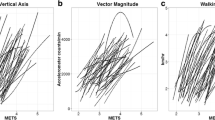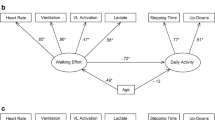Abstract
Cardiorespiratory fitness is an independent predictor of cardiovascular events in women; however, maximal oxygen consumption (VO2max) protocols are not always feasible. The Evaluation of Physical Activity Measures in Middle-Aged Women Study was a 6-week study designed to evaluate six physical activity (PA) measures in women, aged 45–65 years. We investigated the Ebbeling submaximal treadmill (EbbTM) protocol’s ability to reflect an active lifestyle in 66 women [median (IQR) age, 51.0 (48.0, 56.5) years]. Participants were screened using ACSM and AHA guidelines and classified as moderate or low cardiovascular risk. VO2max was estimated using the EbbTM in all participants (TEST1). Moderate risk women repeated the EbbTM (TEST2) while low risk completed a maximal treadmill test. Intraclass correlation coefficients (ICC) and minimal detectable change (MDC90) score were calculated to examine reliability. Spearman rank order or Pearson product-moment correlation coefficients were used to determine the association between estimated VO2max and physical fitness and activity measures. Estimated VO2max from the EbbTM protocol had excellent reproducibility [ICC = 0.95 (95% CI: 0.89, 0.98) and MDC90 was 1.62 mL kg−1 min−1. The EbbTM protocol was associated with measured VO2max (ρ = 0.48; p = 0.01) and was positively correlated with moderate- (ρ = 0.32; p = 0.02), vigorous- (ρ = 0.47; p = 0.0005) and moderate-to-vigorous-intensity PA (ρ = 0.36; p = 0.009), pedometer steps (ρ = 0.41; p = 0.002) and inversely correlated with waist circumference (ρ = −0.58; p < 0.0001), body fat (ρ = −0.55; p < 0.0001), and right leg endurance (ρ = −0.41; p = 0.003). The EbbTM protocol was shown to be reliable and associated with objective measures of fitness and PA in healthy, middle-aged women.



Similar content being viewed by others
References
Armstrong L, Balady GJ, Berry MJ et al (2006) ACSM’s guidelines for exercise testing and prescription, 7th edn. Lippincott Williams & Wilkins, Philadelphia
Balady GJ, Chaitman B, Driscoll D, Foster C, Froelicher E, Gordon N et al (1998) Recommendations for cardiovascular screening, staffing, and emergency policies at health/fitness facilities. Circulation 97:2283–2293
Borg G (1970) Perceived exertion as an indicator of somatic stress. Scand J Rehabil.Med 2:92–98
Brown WJ, Trost SG, Bauman A, Mummery K, Owen N (2004) Test-retest reliability of four physical activity measures used in population surveys. J Sci Med Sport 7:205–215
Caspersen CJ, Powell KE, Christenson GM (1985) Physical activity, exercise, and physical fitness: definitions and distinctions for health-related research. Public Health Rep 100:126–131
Cohen J (1988) Statistical power analysis for the behavioral sciences, 2nd edn. Lawrence Earlbaum, Hillsdale
Crouter SE, Schneider PL, Bassett DR Jr (2005) Spring-levered versus piezo-electric pedometer accuracy in overweight and obese adults. Med Sci Sports Exerc 37:1673–1679
Donnelly JE, Blair SN, Jakicic JM, Manore MM, Rankin JW, Smith BK (2009) Appropriate physical activity intervention strategies for weight loss and prevention of weight regain for adults. Med Sci Sports Exerc 41(2):459–469
Ebbeling CB, Ward A, Puleo EM, Widrick J, Rippe JM (1991) Development of a single-stage submaximal treadmill walking test. Med Sci Sports Exerc 23:966–973
Flouris AD, Metsios GS, Koutedakis Y (2006) Contribution of muscular strength in cardiorespiratory fitness tests. J Sports Med Phys Fitness 46:197–201
Fox EL (1973) A simple, accurate technique for predicting maximal aerobic power. J Appl.Physiol 35:914–916
Freedson PS, Melanson E, Sirard J (1998) Calibration of the computer science and applications, Inc accelerometer. Med Sci Sports Exerc 30:777–781
George JD, Vehrs PR, Allsen PE, Fellingham GW, Fisher AG (1993) VO2max estimation from a submaximal 1-mile track jog for fit college-age individuals. Med Sci Sports Exerc 25:401–406
Glassford RG, Baycroft GHY, Sedgwick AW (1965) Comparison of maximal oxygen uptake values determined by predicted and actual methods. J Appl Physiol 20:509–513
Guralnik JM, Simonsick EM, Ferrucci L, Glynn RJ, Berkman LF, Blazer DG et al (1994) A short physical performance battery assessing lower extremity function: association with self-reported disability and prediction of mortality and nursing home admission. J Gerontol 49:M85–M94
Kasch FW (1984) The validity of the Astrand and Sjostrand submaximal test. Physician Sportsmed 12:47–54
Katzmarzyk PT, Craig CL (2002) Musculoskeletal fitness and risk of mortality. Med Sci Sports Exerc 34:740–744
Landis JR, Koch GG (1977) The measurement of observer agreement for categorical data. Biometrics 33:159–174
Matthews CE (2005) Calibration of accelerometer output for adults. Med Sci Sports Exerc 37:S512–S522
Matthews CE, Hebert JR, Freedson PS, Stanek EJ III, Merriam PA, Ebbeling CB et al (2001) Sources of variance in daily physical activity levels in the seasonal variation of blood cholesterol study. Am J Epidemiol 153:987–995
National Cancer Institute (2009) Risk factor monitoring and methods. http://riskfactor.cancer.gov/tools/nhanes_pam/
Nichols JF, Morgan CG, Chabot LE et al (2000) Assessment of physical activity with the computer science and applications, Inc., accelerometer: laboratory versus field validation. Res Q Exerc Sport 71:36–43
Pettee Gabriel KK, Mc Clain JJ, Lee CD, Swan PD, Alvar BA, Mitros MR et al (2009) Evaluation of physical activity measures used in middle-aged women. Med Sci Sports Exerc 41:1403–1412
Pollock ML, Foster C, Schmidt D, Hellman C, Linnerud AC, Ward A (1982) Comparative analysis of physiologic responses to three different maximal graded exercise test protocols in healthy women. Am Heart J 103:363–373
Pollock ML, Gaesser GA, Butcher JD, Despres JP, Dishman RK, Franklin BA, et al. (1998) ACSM position stand: the recommended quantity and quality of exercise for developing and maintaining cardiorespiratory and muscular fitness, and flexibility in healthy adults. Med Sci Sports Exerc 30
Rossiter-Fornoff JE, Wolf SL, Wolfson LI et al (1995) A cross-sectional validatin study of the FICSIT common data base static balance measures. J Gerontol A Viol Sci Med Sci 50:M291–M297
Town GP, Golding LA (1977) Treadmill test to predict maximum aerobic capacity. J Phys Educ 6–8
Troiano RP, Berrigan D, Dodd KW, Masse LC, Tilert T, McDowell M (2008) Physical activity in the United States measured by accelerometer. Med Sci Sports Exerc 40:181–188
USDHHS (2008) Physical Activity Guidelines for Americans. US Department of Health & Human Services http://www.health.gov/paguidelines/guidelines/default.aspx#toc
Wyndham CH (1967) Submaximal tests for estimating maximum oxygen intake. Can.Med Assoc.J 96:736–745
Acknowledgments
The authors would like to acknowledge the 66 dedicated PAW Study participants and the contributions of research technicians Rebecca Rankin, MS and Justin Leonard. This research was funded by the American College of Sports Medicine, Paffenbarger-Blair Endowment for Epidemiological Research on Physical Activity that was awarded to Dr. Kelley Pettee Gabriel (2007). American College of Sports Medicine (2007 Paffenbarger-Blair Endowment for Epidemiological Research on Physical Activity).
Author information
Authors and Affiliations
Corresponding author
Additional information
Communicated by Klaas Westerterp.
Rights and permissions
About this article
Cite this article
Mitros, M., Gabriel, K.P., Ainsworth, B. et al. Comprehensive evaluation of a single-stage submaximal treadmill walking protocol in healthy, middle-aged women. Eur J Appl Physiol 111, 47–56 (2011). https://doi.org/10.1007/s00421-010-1615-3
Accepted:
Published:
Issue Date:
DOI: https://doi.org/10.1007/s00421-010-1615-3




